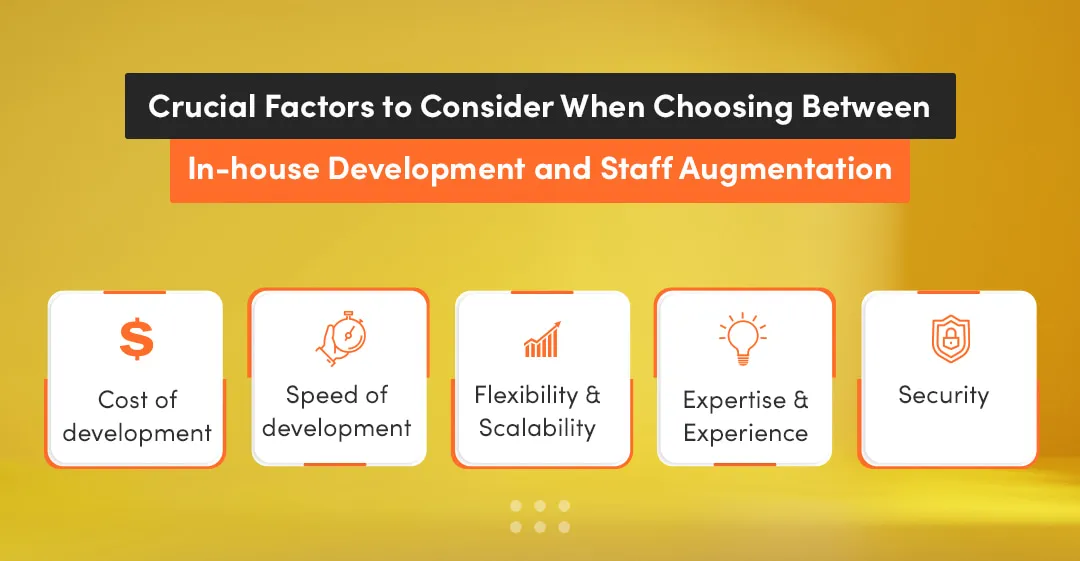Small and mid-sized businesses support the world's economy, which major corporations and big tech companies often overlook. According to the most recent data, there are 33.2 million small businesses in the US alone, which makes up 99.9% of all businesses in the country (SBA, 2022).
Mid-sized, small, and newly formed businesses have very different demands and needs than major organizations when it comes to software development tasks and a budget. Smaller businesses will require their developers to have exceptional research and problem-solving abilities.
The most important issue is whether a small or mid-sized business should employ a specialized software development team or outsource the job.
This article will examine **how internal software development teams and staff augmentation vary. To determine whether or not the approach is better suited for small or mid-sized businesses, we will compare the two approaches against key software development project planning.
In this article, you will learn:
- The Benefits and challenges of in-house software development teams
- What is the potential of staff augmentation?
- Crucial factors to consider when choosing between in-house development and staff augmentation
- Are the data and research supporting the choice?
- Case studies showcasing success stories of companies that have leveraged staff augmentation
- How to analyze your startup needs to pick the smartest choice?
- Why is staff augmentation gaining popularity?
Benefits and Challenges of In-house Software Development Teams

Most mid-sized and small companies lack the specialized in-house development teams and skill sets to create software. It is important to carefully examine the advantages and difficulties of the in-house development technique for mid-sized and small businesses to better comprehend it.
Benefits of the In-house Development Team
There are quite a few significant benefits of in-house development:
Total authority over the team
Businesses will find it simpler to monitor job progress and oversee project execution as they will have easy access to the internal team. Furthermore, organizations are free to train their in-house developers in any way it fits, by the guiding principles of the business.
Improved communication
Developers in an in-house team make face-to-face contact far more convenient and accessible than if they were contracted outside. As a result, a business can speed up project implementation, introduce modifications to the project quicker, and stop comprehension-related problems.
A clearer awareness of the company's principles
As regular employees, in-house team developers are more used to its requirements and principles and are more compatible with its culture. Additionally, they operate differently and move quickly as they are more committed to the project and encourage communication among all project participants.
Coordinated team members
An internal team is frequently more involved than an outsourced development team. This is because a team like this works for the company with which they are affiliated. It is a fact that the entire process of hiring talented developers takes longer but on the other hand you build an entire team of skilled developers that provides long-term benefits and full control of the entire project.
Challenges of the In-house Development Team
Here are the top challenges a midsize or small business may face while recruiting, maintaining, and expanding an in-house development team.
In-house development results in increased hiring costs
According to many companies, the expense of an in-house development team soon exceeds the cost of collaborating with an outsourcing agency, frequently surpassing the other benefits of in-house software development. The expenses of an in-house team are far more complex than just salaries. It includes other employment benefits, provident funds, gratuity, bonuses, and much more, so the cost of in-house development jumps rapidly. Smaller businesses might not have enough turnover to recruit full-time internal staff members.
The need for specialized software and tools
There are always free and inexpensive software development tools available for use by companies. Still, when attempting to build professional software for an exclusive brand, it's typical to use specialized tools and software to produce unique experiences and capabilities inside the app. The work of in-house specialists may become more difficult for the company due to the need for extra training and qualifications.
Outsourcing the development of the project eliminates the concept of spending on tools as the outsourced software development company is responsible for arranging the required tools and tech stack.
Limited talent pool
One of the main reasons companies look for alternatives to in-house teams is the scarcity of talent. It is harder for companies to find and hire the right software development team with the required skill sets.
Longer time required to recruit a new developer
Due to background checks and other recruiting criteria, such as confirming soft talents that suit the company's environment, the search for employees may take considerably longer than expected. The human resources department incurs extra expenses due to the in-house software development team hiring procedure as it takes time to join and introduce a new member to the team.
What is the Potential of Staff Augmentation?

Businesses that require immediate support for completing IT projects sometimes use staff augmentation for guidance. In staff augmentation, temporary workers fill transient employment openings inside a corporation.
Benefits of IT Staff Augmentation
Here are some of the top benefits of hiring a temporary staff:
Fill skill gaps in the workforce
An important advantage of IT staff augmentation is the capacity to employ qualified personnel according to demands. Eventually, a company's IT team will likely face voids that must be replaced immediately. Hiring an internal employee to fill this position is not always cost-effective, especially if the demand is short-term. With the help of IT staff augmentation, outsourcing companies can bring in tech professionals with specific skills or training to work as part of an in-house development team on either a short-term or long-term basis.
Save time on recruitment
Businesses that use IT staff augmentation services can save substantial time by avoiding employee hiring processes. Making thorough job postings, conducting interviews with potential hires, and reviewing the documentation required to bring on a new employee may all take a lot of time. It's quick and simple to find the personnel required to finish IT projects due to a simplified procedure called IT staff augmentation.
Only pay for services you need
IT staff augmentation services let companies only pay for the services they require. Since there is a great demand for IT specialists, businesses can benefit from quick access to skilled and tech specialists who can quickly fill a temporary position and provide a high level of expertise and experience with the help of IT staff augmentation.
Maintain control over employees
IT staff augmentation enables business owners to retain control over their workforce, even when certain activities are delegated to an external company. IT staff augmentation also enables businesses to select which contract employees they wish to engage with, keep authority over who heads the project, and specify how activities should be prioritized.
Simplified exit strategy
The breakdown of the employer-employee connection is one of the organizations' most difficult issues when recruiting in-house software development personnel.
Even if a business is located in a state where non-contractual employment is regarded as "at-will," it is still possible for a lawsuit to be brought against it if a company decides to fire an employee. It is customary for IT staff augmentation to be project-based, which means that when the temporary employee's skills are no longer required, they voluntarily part ways.
Challenges of IT Staff Augmentation
This strategy, nevertheless, obviously has certain drawbacks of its own. Listed are some of the most typical challenges faced by companies when opting for IT staff augmentation:
Finding the right talent
Since there is fierce competition in the technology sector, it can be difficult for businesses to locate qualified workers with the right training and expertise. This problem can be made worse by the strong demand for skilled software development teams. If a company wants to locate the talent they need, they may have to seek outside their immediate region or explore remote employment.
One way to overcome this difficulty is utilizing a recruiting firm with an IT focus. These entities have an immense global pool of competent applicants that may match your company's requirements. It is particularly beneficial for small and mid-sized businesses.
Managing the relationship between the augmented staff and the existing team
Managing the interaction between the augmented and current teams is another difficulty with IT staff augmentation. If new team members are not adequately integrated, the current team's dynamics may be thrown off, leading to conflict.
This can result in a loss of confidence, an imbalance in communication, and other problems that may affect the team's effectiveness.
One option is to provide straightforward means of communication between the expanded team and the current team. This can be achieved through frequent gatherings, team-building exercises, and a mutual understanding of duties. Offering training and support is critical to assist the augmented employees in grasping the company's culture and expectations.
Ensuring the quality of work
Working in remote teams and depending on outsourcing partner contracts might affect the service quality because overseeing and supervising their work can be difficult. This can result in inefficiencies and poor job quality, harming the business's reputation.
The best solution to avoid such challenges is to set up performance metrics and conduct routine performance evaluations to ensure the task progresses as planned. Project management tools can be further used to monitor development and guarantee the quality of work.
Knowledge transfer
Software development for startups can be chaotic if the right knowledge transfer is improper. Missed deadlines and quality problems might result from other team members who cannot follow effective practices for delegating tasks and communicating instructions.
Investing in technologies and resources that make effectiveness, understanding, and skill sharing simple and straightforward to solve the team augmentation difficulty is critical. This might involve mechanisms for complete visibility, openness, user-friendly cooperation, and reliable communication.
Security and compliance
Working with remote employees or teams can be challenging when they lack the same knowledge about sensitive information and systems as the in-house software development team's employees. Security lapses and regulatory violations may come from this, which might harm the business's brand and attract consequences.
To monitor the activities of the augmented employees and ensure they adhere to security regulations, you can utilize security software and solutions.
Try our developers.
Free for 2 weeks.
No risk. Just results. Get a feel for our process, speed, and quality — work with our developers for a trial sprint and see why global companies choose Selleo.
Crucial Factors to Consider When Choosing Between In-house Development and Staff Augmentation
There is too much risk for a small or mid-sized business when investing in project development. Hiring a full-time dedicated in-house development or choosing IT staff augmentation is a highly crucial decision that should be based on numerous factors, such as:

Cost of Development
The per-year salary for a developer in Europe typically ranges between €50,000 and €60,000. Glassdoor says it's about $90,000 in the United States. Joe Hadzima of MIT estimates that additional expenses double this figure by 2.7.
In-house development: In in-house development, the cost is higher because it consists not only of the salary of software engineers but also includes office expenses, software development tools costs, and many more.
Staff augmentation: The remote software developer charges vary by country of origin in Europe and the USA. The typical charge to outsource software development is between $40 to $130 per hour. A small and mid-sized business budget requirement depends on the software's importance. When software becomes the company's foundation, these expenses may eventually pay for themselves.
Speed of development
In-house: On average, an in-house software developer takes 40 days to hire, and businesses have to pay for the costs associated with that process. It means a business must first identify the need for a full-time developer, market the job, conduct interviews, and select the best candidate. Until the selection is made, the development process will be on hold.
Staff augmentation: Finding an IT-augmented service might take anywhere from one to four weeks, depending on needs and level of commitment. With IT augmentation combined with agile methodology, temporary teams may be swiftly formed, resulting in a faster development process.
Flexibility and Scalability
In-house: A team's size should be adjusted based on the project's requirements after evaluating their capacity to deliver extra resources promptly as required. Businesses find it hard to hire or fire employees based only on project requirements. A permanent worker stays in the company irrespective of the completion of the project.
Staff augmentation: Software development projects frequently need to scale up or down in response to shifting needs. It is important to choose a staff augmentation firm that provides flexibility and adaptability.
The smooth progression of the software development process is ensured by a firm with a flexible approach that can assist you in adapting to shifting conditions.
Expertise and Experience
Expertise and experience in in-house approach and outsourcing software development should be one of the first things to look for when choosing a staff augmentation firm or hiring a full-time software developer.
In-house: A business should first create a detailed profile for the expertise and skills needed in a full-time software developer. Candidates should be shortlisted based on experience in the same industry. An expert software developer with the same experience in your industry or project development should be the first choice.
Staff augmentation: An outsourced software development firm with a history of successful projects comparable to yours should be the first choice. It will be easier for a firm to deliver the proper people and guarantee successful project execution if they thoroughly grasp the business needs.
Security
The security of customers' data is highly crucial and cannot be ignored.
In-house: When security is the required project's primary objective, hiring a full-time dedicated in-house developer is highly suggested. Having an in-house team of developers provides more control over the development process, keeping sensitive information within the company.
Staff augmentation: If the required software is going to deal with customers' sensitive and financial data, in such cases, hiring a third-party software development partner or freelance developers might be risky. The reason is simple; a business cannot obtain full control over the development process in case of third-party involvement unless the partnership contract offers NDA. However, software development houses usually offer such non-disclosure agreements for smooth cooperation.
How to Find the Right Staff Augmentation Service Provider?
Businesses wishing to add more expertise to their IT teams must be careful when selecting the IT staff augmentation firm. When choosing a firm to provide IT staff augmentation, remember the following factors to select the best option.
Skills: When outsourcing software development then search for a provider with experience in required fields, such as project management, software development, or cybersecurity. It is more probable that a provider with substantial experience in areas of need would offer top-notch personnel who can assist in reaching your objectives.
Reputation: Seek out a provider with a positive reputation in the labor market. Verify, if the provider has a history of providing high-quality services and skills by reading internet reviews and contacting references.
Recruitment process: To guarantee that they only hire the greatest individuals, look for a company with a strict hiring procedure. Technical expertise and soft abilities like teamwork and communication. These should both be verified by the service provider's methodology.
Adaptability: Find a service provider that can be flexible and adaptable to clients' demands. The provider must be able to deliver talent quickly and make necessary adjustments to projects with shifting requirements.
Communication: Efficacious and open communication are qualities to look for in a service. The provider needs to be ready to offer frequent updates on the progress of your project and be accessible to respond to any inquiries you may have.
Cost: Find a service provider that charges fairly for its products. The provider's experience, reputation, and other aspects should be considered in addition to a fixed price before choosing. So, it is not wise to choose the cheapest option.
Cultural fit: Search for a provider who shares the culture and values same as your business. The service provider should be able to offer personnel that can collaborate well with your permanent team and fit into the culture of your business.
Data and Research Supporting the Choices
Several trends are expected to influence the future of the software development industry, which is evolving quickly. The following forecasts are made on the future of the IT staff augmentation sector, as well as trends for the software development talent pool.
Increased focus on specialized skills
An increased emphasis on specialized talents is required as technology grows more sophisticated. Thus, organizations will need choices that offer these specialized skills and knowledge. Dedicated full-time in-house developers are short in numbers to fulfill the increased demand for knowledge in emerging technologies. However, staff augmentation can fit hard-to-fill positions within your team.
An analysis of the market from 2016-2019 showed employers in the US could only hire 6 for every 10 open tech positions. In stark contrast, companies made 12 hires per 10 job openings for all positions. In other words, it's twice as hard to hire tech candidates.
Increased use of automation
Using automation technologies to speed up hiring, project management, and other procedures will play a bigger part in the IT industry in the future.
Automation will improve the ability of staff augmentation businesses to deliver efficient and affordable services to their clients.
According to CompTIA, in 2019, they estimated 918,000 IT job openings to go unfilled. These numbers would have increased immensely if the IT staff augmentation option had been unavailable. Thanks to agile methodologies, IT jobs are filled by outsourcing partners for staff augmentation
Extension of remote work
Businesses are anticipated to continue seeking remote staffing solutions to take advantage of talent worldwide as the trend toward remote work continues. Outsourcing companies providing staff augmentation services will be well-suited to fulfill the rising demand for remote talent.
Tech employment by 2030 is expected to reach around 9 million positions. So that's an increase of 1 million. At the same time, there is a need to replace workers leaving the sector due to retirement and other reasons. This is estimated to be around 580,000 per year.
It is proven with simple math that filling 580,000 job positions is impossible to fill all full-time developers positions. However, augmented service providers can outsource development teams to improve the development speed for businesses around the globe.
How to Analyze Your Startup Needs to Pick the Smartest Choice?

Along with major factors to consider before choosing between an in-house software developer and IT staff augmentation, a business needs a detailed analysis of the current situation and future requirements. Here are the steps needed to take to make a better decision:
Step # 1: Define the project scope
A business should have a clear and solid understanding of the project scope. The purpose of developing the app should be clearly defined. All required details, including the list of features, tech stack, and budget, should be available in writing to measure the project scope.
By answering these questions, it will be easier to identify the project scope. For instance, if the project's scope is large and long-term, then considering a dedicated team model is beneficial for extended collaboration between team members.
On the other hand, staff augmentation is considered beneficial if the project has low scope and is required for the short term with specific needs.
Step # 2: Define the requirements in detail
It's critical to have clear, specific standards that can be followed. The in-house development team knows what is necessary to develop the software. This step will answer the following questions:
- What will be the required technology stack?
- What is the required tech expertise?
- Examining the final solution's layout UI/UX
- List of desired features in the app
- Required skill set to develop the app
- Estimated time duration
This step will help to understand if your project needs multiple talents or a specific specialty.
Step # 3: Communicate about the budget
Cost is always the most concerning factor in making the final decision. If a business is looking for a cost-effective solution, staff augmentation and extended teaming can be a great idea, as with the dedicated team, higher costs are involved due to reliable resources and infrastructure.
Mid-sized businesses can happily select a dedicated team or an individual software developer. Still, small-sized and startup businesses will have to face a lot of struggle in engaging a dedicated expert tech developer.
Step # 4: Pick the right choice
After analyzing important factors, possible challenges, project scope, and budget - a business will be in a much better position to decide whether to go with a dedicated in-house development or IT staff augmentation.
There is a possibility that both options seem a good fit for the company. In such cases, a business should consider outsourcing software development consultants for expert guidance. Small and startup businesses lack the expertise and experience to make the final decision, so consulting an expert is the best option.
Why Is Staff Augmentation Gaining Popularity?
Particularly in recent years, staff augmentation services have swiftly become increasingly popular. There are various reasons why this occurs. Here are some forecasts about the future of the IT staff augmentation sector:
Lack of IT Specialists in the Local Market

A CBI/TCS analysis claims that the UK alone loses £63 billion ($87 billion) annually due to businesses being unable to locate experts with the necessary digital knowledge. At the same time, CNBC reports that approximately 1 million IT jobs are still open in the US. Statista emphasizes the increased popularity of staff augmentation services from 5.2% to 6.3% between 2018 and 2020.
These figures demonstrate that an increasing number of businesses worldwide use staff augmentation services to identify IT developers with the necessary technical capabilities and fill open positions.
Difficulties With Hiring Specialists for In-House Development Teams
The Covid-19 pandemic in 2020 caused a rapid change in the world's working habits toward remote workers. As more office employees and teams went online, they effectively established remote communication and cooperation.
Many businesses can overcome this issue by using staff augmentation services and recruiting people online worldwide.
Reduction in Costs
Companies considerably lower their costs when they outsource development teams. They might hire developers for a limited time to focus on a specific project component. This enables the avoidance of overhead expenditures for full-time employees related to the payment of benefits, full-year salary, and other costs such as recruiting fees.
Additionally, due to reduced labor costs, IT professional salaries in Eastern Europe are significantly lower than in most European or American nations.
Summary
Whether a business has short-term or long-term growth goals, hiring a dedicated in-house development team and staff augmentation can help companies grow faster and achieve their goals. This article offers helpful insights to help you choose the best approach for your project based on several factors like a company's budgets, recruitment, technical skill sets of current employees, project security, and deadlines.
When choosing staff augmentation, it is crucial to consider at least three main factors: a proven track record of success, strong communication skills, and high responsiveness. These are some of the most important factors that cannot be ignored.
Finding an ideal software partner can be difficult, but once you find your match, your organization will thrive with a quick workforce scale-up, improved quality, and no skills gaps.





